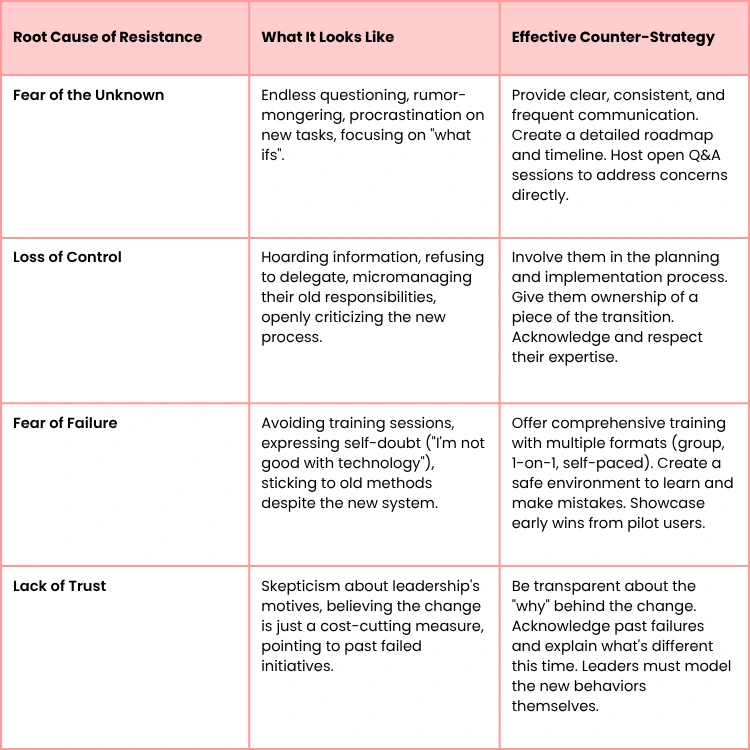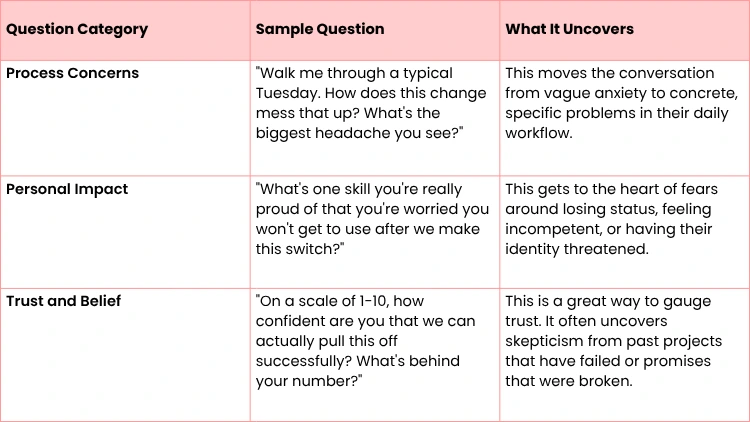Overcoming Resistance to Change: Proven Action Steps

To have any shot at leading a successful change, you first need to accept a fundamental truth: resistance is normal. It's a human response. People aren't being difficult; they're reacting to the fear, uncertainty, and potential loss of control that change brings.
The goal isn't to steamroll over these feelings. It's to shift your approach from enforcing a new rule to guiding people through a transition they feel a part of.
Jump To Section

Earn As You Learn
Earn 25% commission when your network purchase Uplyrn courses or subscribe to our annual membership. It’s the best thing ever. Next to learning,
of course.
Why Most Change Initiatives Fail
It's a sobering statistic, but it's one every leader needs to hear: a staggering 70% of organizational change initiatives fail. A McKinsey Global Survey points the finger at one primary culprit—employee resistance.
This isn't a failure of the new strategy, the new software, or the new org chart. It's a failure to account for the human element. When you announce a change, your team doesn't just hear about a new process. They hear a threat to their routine, their competence, and maybe even their job security. That triggers a natural, protective response. Resistance isn't just stubbornness; it's a signal.
The Anatomy of Resistance
Pushback isn't a single action. It's a whole spectrum of behaviors, and they're all fueled by very specific anxieties. If you want to get ahead of it, you have to understand what’s really going on under the surface.
Most resistance boils down to a few core fears:
- Fear of the Unknown: People crave predictability. An ambiguous future is far more stressful than a challenging but familiar present.
- Practical Example: An employee might worry, "The new software is coming, but no one has said when training is, or if I'll have time to learn it. I'm afraid I'll fall behind."
- Loss of Status or Control: A new process might sideline an experienced employee, diminish their autonomy, or make them feel less important. That’s a tough pill to swallow.
- Practical Example: The senior accountant who perfected the old manual invoicing system now feels like a novice with the new automated software, losing their status as the office 'go-to' expert.
- Fear of Failure: Think about the people who have mastered their current roles. They worry they won't be able to adapt, that they'll look incompetent, and that their value to the company will plummet.
- Practical Example: A salesperson who relies on personal relationships fears that a data-driven CRM will expose their "old school" methods as inefficient, making them look bad.
Actionable Insight: Treat resistance as valuable feedback. It’s a signal that you've overlooked a genuine concern or failed to communicate the vision in a way that connects with your team's needs and fears. Your first step should always be to listen, not to push back.
A Real-World Scenario: The Failed CRM Rollout
I saw this play out perfectly at a mid-sized company rolling out a new CRM. On paper, it was a no-brainer—more powerful, more efficient, better data. Management sent a company-wide email highlighting all the great new features and expected everyone to jump on board.
They completely misread the room.
The veteran sales team didn't see a new tool; they saw a threat. They were worried the steep learning curve would slow them down and torpedo their commissions. They were convinced the new transparency features were just a way for management to micromanage them.
The result? Classic passive resistance. Data entry was sloppy, deadlines were missed, and you'd find reps secretly using their old, familiar spreadsheets. A multi-million dollar investment went down the drain because leadership ignored the human side of the equation. Incidents like this are a stark reminder of why successfully managing culture change in the workplace is so critical.
Ignoring resistance is a direct path to failure. But if you acknowledge it and plan for it, you open up a path to genuine, lasting success.
Decoding Resistance: What It Looks Like and How to Respond
To help you connect the dots, I've put together a quick-reference table. It links common resistant behaviors to their likely root causes and gives you a starting point for how to respond as a leader.
Think of this table not as a rigid script but as a diagnostic tool. When you see the behavior, you'll have a much better idea of the real problem you need to solve.

Diagnosing the True Source of Resistance
When you hit a wall of resistance, your first instinct might be to push harder. But that’s like trying to fix a rattling engine by turning up the radio—you’re just ignoring the problem.
Resistance is almost never about the change itself. It's a symptom. It’s the surface-level expression of a much deeper issue. To actually move forward, you have to stop treating the symptom and start playing detective to find the real cause.
Think about a sales team fighting a new CRM. Their complaints about "clunky software" might be what you hear, but that's rarely the whole story. The real fear? It could be a terror that the new system will slow them down, kill their commissions, and make them look incompetent in front of everyone. Getting past the pushback starts by putting on your diagnostic hat.
Uncovering the Hidden Truths
So, how do you get to the truth? You have to create a space where people feel safe enough to be honest. Most employees aren't going to voice their genuine anxieties in a big town hall or to a manager they don’t completely trust. You need to gather intelligence from a few different angles.
The data confirms this. A 2023 workplace report revealed that 37% of employees actively resist organizational change. The reasons they give aren’t about the new software or process. Instead, it’s about a lack of trust in leadership (41%), a deep-seated fear of the unknown (38%), and a failure to communicate the "why" (39%). You can dig into similar findings about why employees resist change.
To get that kind of unfiltered feedback, you need the right tools.
- Anonymous Pulse Surveys: Fire up a simple Google Forms or SurveyMonkey survey. Ask direct questions about feelings and perceptions, not just logistics.
Actionable Insight: Instead of asking "Do you have concerns?", ask "What is your biggest concern about the upcoming change?" This open-ended question invites a more detailed, honest response.
- Small-Group Feedback Sessions: Forget the all-hands meeting. Pull together intimate groups of 5-7 people from various departments, and—this is key—without their direct managers in the room. This creates a much safer dynamic where people feel more comfortable sharing what they’re really worried about. For more on this, check out this guide on introducing change to teams effectively.
Actionable Insight: Your job in these sessions is not to defend the change. It's to listen. Seriously, that's it. Ask questions, nod, and take notes. The second you start justifying the plan, you’ve lost the room and shut down any hope of honest dialogue.
Powerful Questions to Ask
The quality of your diagnosis comes down to the quality of your questions. "What do you think?" is useless. You need to ask questions that are designed to peel back the layers and uncover specific fears.
When you use these diagnostic tools, you stop fighting a faceless monster called "resistance". Instead, you start solving specific, well-defined problems. You might find out the issue was never the new software—it was a deep-seated belief that management doesn’t follow through. And that is a problem you can actually start to fix.
Here are a few questions you can adapt to get the conversation started:

Building a Foundation of Trust and Transparency
When people start pushing back against a change, the knee-jerk reaction for many leaders is to throw more data at the problem. More charts, more PowerPoints, more process flows. But here's the thing: you can't build trust with a spreadsheet. Trust is the actual bedrock of any successful change, and without it, even the most bulletproof plan will be met with skepticism.
This is where real, authentic communication comes in. It’s not just about broadcasting the "what" and "how". Your team needs to hear the "why"—the straight, unfiltered reason this change is critical for the company's long-term health.
Crafting a Transparent Communication Roadmap
A single, vague announcement is a recipe for disaster. It creates a vacuum that will instantly be filled with rumors, gossip, and worst-case scenarios. You need to get ahead of the narrative with a transparent communication roadmap. Think of it less like a one-off memo and more like a sustained campaign to keep everyone in the loop.
Your roadmap should spell things out clearly:
- The Timeline: Give people specific phases and milestones. Knowing what’s coming and when helps manage anxiety.
- The Full Impact: Be brutally honest about the good and the bad. Acknowledging that there will be a learning curve or some temporary chaos shows you respect your team’s intelligence.
- Dedicated Feedback Channels: Set up clear, safe avenues for questions and concerns. This could be dedicated office hours, a town hall, or even an anonymous feedback form.
Solid communication is the engine of any change initiative; it's what builds trust and keeps things moving. If you're looking to really sharpen your skills here, digging into resources on mastering change management communication can offer some fantastic strategies.
Actionable Insight: When you're open about the challenges ahead, you're not showing weakness—you're building credibility. People are far more likely to trust a leader who admits, "The first month of this transition will be tough," than one who pretends it's a perfectly smooth ride.
Fairness is Non-Negotiable
Transparency directly feeds into something even more crucial: a sense of fairness. How people perceive the fairness of a change is one of the biggest predictors of whether they’ll fight it or get on board. When your team feels the process is just and the decisions are transparent, resistance just naturally starts to melt away.
Think about the massive difference between how two companies might handle layoffs.
- Company A (The Secretive Way): For weeks, management is locked in closed-door meetings. Rumors fly, anxiety spikes, and work grinds to a halt. The layoffs are finally announced in a cold, impersonal email. The people who are left feel demoralized and completely distrustful. It’s a PR nightmare that often triggers a wave of voluntary resignations from their best people.
- Company B (The Transparent Way): Leadership gets out in front of it. They announce the financial struggles, explain exactly why layoffs are unavoidable, and clearly outline the criteria for who is affected. They also provide generous severance and job placement help. The news is still tough, but the process feels fair and respectful. Trust is maintained, and morale, while bruised, recovers much faster.
This kind of open approach does more than just manage a crisis; it turns skeptical team members into genuine partners in the process. It also powerfully reinforces the prominence of psychological safety, sending a clear message that people's concerns are valid and will actually be heard.

Fostering Ownership Through Co-Creation
What's the most effective way to dismantle resistance? It’s surprisingly simple: make your team part of the solution. People rarely fight something they helped build. When you shift away from a top-down mandate and embrace co-creation, you turn skeptical employees into committed partners.
Forget the dusty old suggestion box. True co-creation means actively involving your team in shaping the change itself. This fosters a powerful sense of ownership that no amount of executive communication can ever replicate.
From Passive Recipients to Active Architects
The first move is to change your team's role from passive recipients of change to its active architects. This doesn't mean management steps back entirely; it means you guide a truly collaborative process. The goal is to create a structure where their insights and expertise directly influence the final outcome.
Here are a few practical ways to get this done:
- Structured Workshops: Instead of just presenting a finished plan, host sessions where teams can map out the new process, flag potential roadblocks, and brainstorm solutions together. For a deeper look at this approach, check out this guide on co-creating team working agreements.
- Pilot Programs: Find a small, willing group to test the new system or process. Their real-world feedback is gold for refining the approach before a full-scale rollout. Plus, they become your first success story.
- "Change Champion" Networks: Every team has natural influencers—the people others turn to for advice. Identify them. Empower them with information and pull them into key decisions. They'll become your most credible advocates, translating the vision to their peers in a way leadership simply can't.
Actionable Insight: When you invite people into the change process, their perspective shifts from "What are they doing to us?" to "What are we building together?" This is the single most important mindset change for ensuring a smooth transition.
A Practical Example of Co-Creation
Imagine a manufacturing plant getting intense pushback on a new set of safety protocols. The rules were technically sound, but the frontline workers saw them as clunky and impractical for their day-to-day tasks. Resistance was immediate and widespread.
Instead of just forcing the new rules, the plant manager created a "Safety Task Force". The group was made up of respected, experienced workers from the plant floor—and yes, it included some of the most vocal critics.
Their mandate was straightforward: test the new protocols for two weeks, document every single problem, and propose better, more practical solutions that achieved the exact same safety goals.
The results were remarkable. The task force didn't just identify critical flaws; they designed smarter, more efficient procedures that their peers would actually follow. Because they built it, they owned it. They turned into vocal supporters, training their colleagues and championing the very change they once resisted. The resistance was effectively overcome from within.

Providing Practical Support During the Transition
Alright, you've secured buy-in. That's a huge milestone, but don't pop the champagne just yet. The transition phase is where even the most brilliant strategies can fall apart. Overcoming resistance to change takes more than a compelling vision; it requires real, practical support systems to help new habits stick.
Without that scaffolding, people will almost always drift back to what’s comfortable and familiar.
The bedrock of this support is good training. And I don't mean a generic, one-size-fits-all workshop. You need targeted sessions that directly address the new skill gaps. For instance, if you're rolling out new project management software, the training can't just be a tour of the features. It has to show the team exactly how to use those features in their day-to-day work. For a deeper dive into designing effective sessions, this guide has some great employee training program examples you can borrow from.
Creating a Safety Net for Success
Beyond formal training, you've got to create clear, accessible channels for help. The goal is simple: make it easier for people to ask for help than to struggle alone. This "safety net" is what builds confidence and keeps things moving during that awkward learning curve.
Think about a multi-channel support system:
- A dedicated Slack channel: This becomes the go-to spot for quick questions and peer support.
- Practical Example: A channel named #new-crm-questions where anyone can post a screenshot of an error message and get a quick solution from a colleague or the project lead.
- 'Expert Office Hours': Block out specific times when a designated expert is available for one-on-one troubleshooting.
- Practical Example: Every Tuesday from 2-4 PM, Sarah from IT is available in a dedicated Zoom room for live help. No appointments, just open-door support.
- Easy-to-find resources: Build a simple, searchable knowledge base. Think short video tutorials and quick-reference guides, not a 50-page manual.
- Practical Example: A one-page PDF cheat sheet pinned in the Slack channel that covers the 5 most common tasks in the new system.
This is also about fostering a mindset of continuous learning. A big part of practical support is showing people how to thrive in the age of AI and automation. It reframes the change from a one-time pain into an ongoing opportunity to grow.
Actionable Insight: Realistic timelines are a form of support. Build a learning curve directly into your project plan. Expecting immediate perfection is a surefire way to demoralize your team and invite resistance. Instead, set achievable goals for the first week, the first month, and the first quarter.
Building Momentum with Small Wins
Finally, never, ever underestimate the power of celebrating progress. Big, sweeping changes feel overwhelming. Breaking the journey into smaller, recognizable milestones makes the whole thing feel manageable and keeps motivation high.
I saw this in action with a retail chain rolling out a complex new inventory system. The pushback was intense. Instead of focusing on the massive end goal, they started celebrating small wins publicly. Each week, they’d announce the first few stores that successfully hit their initial adoption targets.
This simple act did two things. First, it offered social proof that the new system wasn't impossible. Second, it sparked friendly competition between locations. Store managers started sharing tips to help each other get on the board. By celebrating the small stuff, they turned a dreaded mandate into an energizing, shared challenge.

Common Questions About Managing Change Resistance
Even with the best-laid plans, you're going to hit some snags. Overcoming resistance to change often throws some tricky, real-world curveballs your way. Let's tackle some of the most common questions I hear from leaders in the trenches.
What If Resistance Comes From a Key Manager or Top Performer?
When one of your most influential people starts pushing back, it’s a delicate situation. The absolute last thing you want to do is address this in a group meeting. That just creates a power struggle.
Instead, pull them aside for a one-on-one. Your goal here is to listen, not to lecture. Dig into what’s really bothering them. Are they worried about losing status? Is this change piling more onto their already-full plate? Are they concerned they’ll lose control over their team?
Actionable Insight: Start the conversation with empathy, not data. Try saying, "I get the sense you have some real concerns about this new process. Can you walk me through your perspective? I want to understand what you're seeing." This validates their importance and opens the door to a real conversation. If they raise valid points, involve them in tweaking the rollout plan. This is how you turn a powerful resistor into an even more powerful champion for the change.
But what if they just won't budge for personal reasons? At that point, you have to be firm. Reiterate that the change is happening and that, as a leader, their role is to guide their team through it successfully. Offer your full support, but make the expectation clear.
How Do You Handle Passive Resistance Like Missed Deadlines?
Ah, passive resistance. The silent killer of change initiatives. It's the missed deadlines, the quiet non-compliance, the "I forgot" excuses. It's often more damaging than outright opposition because it's so slippery and hard to confront directly.
The secret to beating it? Remove all the ambiguity. You have to make expectations crystal clear and measurable.
Don't just say, "Everyone needs to start using the new software." That's too vague. Instead, set a specific, short-term goal: "Log 100% of your client interactions in the new CRM by the end of the day Friday." Now you have a clear benchmark for what success looks like.
Then comes the most important part: consistent follow-up. When someone misses that deadline, you have to address it immediately. Frame the conversation around support ("What roadblocks did you run into?") rather than accusation. This forces them to make a choice—either get on board or openly explain why they're not, which you can then manage head-on.
Actionable Insight: Don't let passive resistance slide. By making accountability clear and consistent, you remove the gray area that allows it to thrive. Your follow-up signals that the change is a priority and not just another passing initiative. A simple, non-confrontational check-in like, "Hey, I noticed your logs from Friday aren't in yet. Is everything okay?" is often enough to get things back on track.
Our Team Is Burned Out. How Do We Implement Another Change?
If your team is already running on fumes, asking them to adopt something new can feel like a slap in the face. This is where your framing and empathy are critical. You absolutely must position the change as a solution, not just another burden.
First, acknowledge the burnout. Say it out loud. Let them know you see how hard they're working and that you understand their stress. It shows you’re in touch with their reality.
Next, you need to paint a vivid picture of how this new process or tool will make their lives easier in the long run. Will it automate those mind-numbing manual reports? Will it cut down on redundant meetings? Get specific and focus on alleviating their current pain points.
- Practical Example: Instead of saying, "We're implementing a new workflow system", say, "I know you're all tired of chasing down approvals via email. This new system will automate that entire process, saving you an estimated three hours a week. We're doing this for you." This reframes the change from more work to a direct solution for their burnout.
Of course, words aren't enough. You have to back it up with action. This means providing extra resources, extending timelines to be more realistic, and maybe even temporarily shelving less critical tasks to give them some breathing room. And as they start adopting the change, celebrate every small win. Each step forward is a step away from the old, stressful way of working.
At Uplyrn, we believe that building new skills is the most powerful way to navigate change successfully. Our platform offers expert-led courses and practical resources designed to equip you and your team with the confidence and capabilities needed to thrive in any transition. Explore our courses today and turn change into your next big opportunity.


Leave your thoughts here...
All Comments
Reply